�
5G Americas White Paper: Cellular V2X Communications Towards 5G
TABLE OF CONTENTS
Executive Summary ...................................................................................................................................... 3
1. Introduction ............................................................................................................................................... 3
2. Current V2X Landscape ............................................................................................................................ 4
2.1 V2X Overview ...................................................................................................................................... 4
2.2 Standards and Industry ....................................................................................................................... 7
2.3 Expected Benefits ................................................................................................................................ 9
3. 5G-based V2X ......................................................................................................................................... 11
3.1 Description of 5G ............................................................................................................................... 11
3.2 5G for Automotive Sector .................................................................................................................. 12
3.3. C-V2X and DSRC Comparison ........................................................................................................ 20
4. Advanced Use Cases .............................................................................................................................. 24
4.1 Advanced Driving with Intent/Trajectory Sharing .............................................................................. 24
4.2 Extended Sensors ............................................................................................................................. 24
4.3. Platooning ......................................................................................................................................... 25
4.4 Remote Driving ................................................................................................................................. 26
4.5 DATA Uplink ...................................................................................................................................... 27
4.6 Real-Time HD Mapping ..................................................................................................................... 27
5. Stakeholders and their Roles .................................................................................................................. 27
5.1 Mobile Network Operators ................................................................................................................. 27
5.2 Vehicle Manufacturers ....................................................................................................................... 29
5.3. The Role of Cloud Service Providers ............................................................................................... 30
5.4. Spectrum and Regulatory Aspects ................................................................................................... 30
Annex: NPRM response summary .............................................................................................................. 32
6. Conclusion .............................................................................................................................................. 35
Appendix A: Acronym List ........................................................................................................................... 36
Acknowledgements ..................................................................................................................................... 38
March 2018
�
5G Americas White Paper: Cellular V2X Communications Towards 5G
EXECUTIVE SUMMARY
The automotive industry is evolving toward connected and autonomous vehicles that offer many benefits,
such as improved safety, less traffic congestion, less environmental impacts and lower capital expenditure.
A key enabler of this evolution is vehicle-to-everything (V2X) communication, which allows a vehicle to
communicate with other vehicles, pedestrians, road-side equipment and the Internet. With V2X, critical
information can be exchanged among vehicles to improve situation awareness and thus avoid accidents.
Furthermore, V2X provides reliable access to the vast information available in the cloud. For example, real-
time traffic, sensor and high-definition mapping data can be made available, which is useful not only for
today’s drivers but will be essential for navigating self-driving vehicles in the future.
The paper’s first section describes the current status of V2X, with a focus on the Americas region. It also
provides insights into how emerging 5G technologies will accelerate the realization of advanced V2X
communication to improve transportation experience and quality of life. For example, 5G-based V2X is
expected to enable very high throughput, high reliability, low latency and accurate position determination
use cases. Some of the use cases will involve 5G working in tandem with other technologies including
cameras, radar and lidar. Cellular V2X Communications Towards 5G describes these use cases, starting
with the advanced driving categories identified in 3GPP, including ranging/positioning, extended sensors,
platooning and remote driving. The paper also describes how mobile network operators, vehicle
manufacturers, cloud service providers and regulatory bodies can work together to deliver a brand-new
experience for drivers, travelers and other road users in the near future.
1. INTRODUCTION
Technologies for connected and autonomous vehicles are rapidly improving. The benefits for daily life are
clear and widespread, including increased safety, less gridlock, reduced environmental impact and more
creature comforts for drivers and passengers alike. V2X technologies are key enablers of this evolution.
The paper describes the role that 5G will play in enabling cellular-based V2X communications. V2X’s
evolution to 5G is clear via the 3rd Generation Partnership Project’s (3GPP) “New Radio (NR)” access
technologies. These services will unleash the true potential and synergy of connected and autonomous
vehicles because 5G will deliver unprecedented quality of service, including low latency, enhanced
broadband access and ubiquitous connectivity.
V2X communications have already been standardized by 3GPP, based on LTE Release 14, as described
in the 2016 5G Americas whitepaper, V2X Cellular Solutions. That technology is slated to support V2X
communications for basic safety use cases. In current and future releases, 3GPP is working on specifying
5G technologies, and with it, 5G-based V2X. It is important to note that the 5G radio access enhancements
will enable advanced use cases for data exchange but will not duplicate the 4G-based V2X functionality.
This way, 5G V2X services are additive to the foundational capabilities of LTE V2X. Indeed, 5G will be
future-proof and backwards compatible with LTE V2X.
The paper is organized as follows:
Section 2 describes the current V2X landscape, including standards and industry status with expected V2X
benefits.
March 2018
�
5G Americas White Paper: Cellular V2X Communications Towards 5G
Section 3 provides details about 5G-based V2X communication, including 5G standards and impacts on
the automotive sector with details around architecture, use cases and security aspects. The section also
compares V2X and Dedicated Short Range Communication (DSRC) technologies.
Section 4 explores the advanced use cases that 5G-based V2X communication will enable to accelerate
the development of V2X. It also explores the 5G-based V2X impacts on various stakeholders and identifies
areas of collaboration between them.
2. CURRENT V2X LANDSCAPE
This section summarizes the current V2X landscape in the U.S., Europe and Asia. It also discusses V2X
deployment considerations and expected benefits.
2.1 V2X OVERVIEW
The automotive industry is in the midst of a transition toward producing vehicles that are more aware of
their surroundings. For many years, there has been a goal that vehicles should be able to communicate
with not only other vehicles (V2V) but also with nearby infrastructure (V2I), Internet-based networks (V2N)
and even pedestrians (V2P). Collectively these use cases have become known as vehicle-to-everything
(V2X) connectivity. Now, with advances in electronics, sensing technologies and computing techniques
such as machine learning and computer vision, this use cases are starting to become reality. New vehicles
today are capable of taking a more active role by warning drivers of potential collisions with oncoming
vehicles, assisting with emergency braking and monitoring intersections, to name just a few examples. This
represents a big step forward from relying on passive safety features such as seat belts and air bags.
In the automotive industry, this trend is viewed as the beginning of an evolution to automated and eventually
fully autonomous vehicles. In an autonomous vehicle scenario, the vehicle’s on-board computers will be
fully capable of performing all driving operations on their own, with no human monitoring required. This is
still a few years away, but today we are getting closer with the likes of Tesla providing partial automation
and Google’s self-driving car testing conditional automation.
In the U.S., the NHTSA is considering using IEEE 802.11p-based DSRC technology for V2V
communications. The technology was developed specifically for V2V applications that require critical
latency of ~100ms, very high reliability and security authentication with privacy safeguards. The DSRC
standard was finalized in 2009 and has been subjected to extensive testing by automakers and select large-
scale trials. Stakeholders have completed work on use of DSRC to protect vulnerable road users.1 The
Federal Communications Commission (FCC) has allocated dedicated spectrum for transportation safety
applications in 1999 in the 5.850-5.925 GHz band to ensure operation without interference that DSRC-
based V2V systems plan to leverage.
However, DSRC has several weaknesses. There is no apparent path for continued evolution of the radio
standard to meet changing technological and consumer needs.2 Additionally, as it was designed for rapid
transmission of short-range basic safety messages, it is unable to meet the higher bandwidth demands of
V2N applications such as autonomous driving, multimedia services. DSRC also doesn’t have the bandwidth
necessary to transmit the raw vehicle sensor data that will become increasingly common in automated
1 SAE standards, SAE International, March 2017
2 In contrast, a number of standards based on DSRC have been developed by stakeholders. See Applications development is also
extensive: https://www.its.dot.gov/pilots/cv_pilot_apps.htm
March 2018
�
5G Americas White Paper: Cellular V2X Communications Towards 5G
vehicles. DSRC also has limited range: about 300 m. For more details, see the 5G Americas whitepaper
published in 2016, “V2X Cellular Solutions.”
DSRC would require the deployment of tens of thousands of roadside units (RSUs) embedded or attached
to roadway infrastructure to enable an effective network along the nation’s roads. This is a particular
challenge in more rural areas considering the vast distances involved. State highway administrations and
other roadway authorities would be responsible for deploying, managing and operating the RSUs and
associated infrastructure networks, such as fiber or copper backhaul. While V2V communications do not
require RSUs to perform crash-warning functions, RSUs are needed for ancillary functions such as
certificate revocation list (CRL) distribution, certificate top-ups and to support other longer-range V2X use
cases.
LTE and 5G can be used for these RSU functions thereby eliminating the need for highway authorities to
install and maintain RSUs. That highlights another a key disadvantage for DSRC: The need for another set
of radios when all new vehicles already come with embedded cellular radios. By using cellular technologies
for both short and long-range use cases, OEMs can reduce vehicle bill of materials (BOM) costs while
meeting or even exceeding the safety requirements.
Beyond a technology comparison, however, there are other policy considerations that will need to be
resolved for LTE-based V2X to be embraced by stakeholders. These include the universal availability of
V2V or other safety-related applications for vehicle owners that choose not to activate their mobile network
operator SIM card for cost or privacy reasons, a revised set of liability issues and the ability of state highway
authorities to interface with an LTE network that they do not operate.
Recently, attention has also been focused on cellular LTE technology which is quickly evolving to meet the
needs for V2X communications. The current LTE standard in 3GPP Release 13 is not capable of meeting
the low-latency and high-speed requirements of safety-critical V2V applications. Also, vehicles in areas with
poor or no network coverage would be unable to communicate with each other. Despite these limitations,
LTE Release 13 is capable of meeting some of the less stringent V2N use cases today. However, the
completed 3GPP Release 14 LTE standard does include support for cellular-V2X (C-V2X) use cases,
enabling cellular technology as an additional option for the majority of V2X applications. With LTE Release
14, direct device-to-device communication improves latency and support operation in areas without network
coverage and at high relative speeds, while network broadcast capabilites can help to meet other V2X
requirements. In addition, the ability to leverage existing cellular infrastructure, with its broad coverage
footprint, would reduce costs and accelerate the realization of the safety and efficiency benefits of V2X
communication.
As U.S. regulatory agencies look toward finalizing proposed legislation and the details behind V2X
communication, the planning for and implementation of V2X services in Europe is progressing along a
different path. In April 2015, the European Parliament passed legislation requiring all new cars to be
equipped with eCall technology, 3 which is the ability to automatically dial Europe’s single emergency
number in case of an accident. The law requires every new vehicle produced after April 2018 to be equipped
with integrated cellular technology, thereby seeding the vehicle base with cellular-capable vehicles. To
address vehicle connectivity, the European Commission adopted a coherent strategy4 in 2016. The strategy
aims to promote an integrated European market that supports common priorities and would leverage both
cellular communications and European Telecommunications Standards Institute - Intelligent Transport
Systems - G5 (ETSI ITS-G5), a standard based on IEEE 802.11p and similar to DSRC. Spectrum resources
3 European Commission, “eCall in all new cars from April 2018”; April 2015.
4 European Commission, “An EU strategy on cooperative, connected and automated mobility”; November 2016.
March 2018
�
5G Americas White Paper: Cellular V2X Communications Towards 5G
for V2X communication in Europe have been allocated in the 5.9 GHz band, similar to the U.S. The strategy
outlined by the European Commission will serve as the foundation for implementing the necessary legal
framework in 2018 that will enable the commercial deployment of cooperative intelligent transportation
systems by 2019.
A more fragmented approach is playing out in Asia. China plans to decide on unified standards for V2V and
V2I communication in 2018,5 an important step given the country’s large population and growing global
economic importance. In contrast, in Japan, Toyota introduced vehicles capable of V2V and V2I
communication using DSRC back in 20166 and continues to develop more advanced capabilities.7
Japan’s DSRC uses a different band (760 MHz) and a different standard (Association of Radio Industries
and Businesses ARIB STD-109). It is still based on IEEE 802.11p but differs substantially in the physical
layer. Korea has also focused significant attention on the testing of automated vehicles as of late, with the
hope of deploying some automated vehicles for the 2018 Olympics in Pyeongchang. Korea has also
designated spectrum in the 5.9 GHz band for intelligent transportation systems.
These differences around the world illustrate that there are strategic planning and deployment choices to
be made. The C-V2X 3GPP standard was completed in March 2017,8 with products underway. Table 1
compares DSRC, Release 14 C-V2X and 5G C-V2X at a high level.
Table 1. High-Level Comparison of Attributes for DSRC, LTE V2X and 5G V2X.
KEY ELEMENTS
Out-of-network operation
Support for V2V
Support
uses
Support for V2P
for safety-critical
Support for V2I
Support
services
Network coverage support
for multimedia
Global economies of scale
Regulatory/testing efforts
Very high throughput
Very high reliability
DSRC/
IEEE
802.11
limited
limited
Rel 14 C-
V2X
limited
5G C-V2X (Rel
15,16) (expected)
*
5 Reuters, “China to set communication standard for driverless cars after 2018”; December 2016.
6 Traffic Technology Today, “Toyota to introduce world’s first DSRC-based V2X system in production cars”; 2015.
7 Toyota, “V2X Systems in Japan”; 2016.
8 3GPP, “Initial Cellular V2X standard completed”; September 2016.
March 2018
�
5G Americas White Paper: Cellular V2X Communications Towards 5G
ranging
Wideband
positioning
Very low latency
and
*Note: Rel-15 is LTE-based and supports basic safety messaging just like Rel-14 V2X. Rel-16 will include the
capabilities of Rel-14 and 15 and add support for more advanced use cases via 5G NR-based V2X
LTE Release 14 C-V2X can be viewed as a necessary waypoint along the timeline for 5G development, as
it supports safety-critical use cases. As 5G technology evolves, 5G-based C-V2X will be able to take
advantage of the enhanced mobile broadband, ultra-reliable low-latency communication and massive-scale
machine-to-machine communication, all of which will support more advanced use cases (see Section 4).
For backward compatibility, a 5G V2X-enabled vehicle will support not just these advanced services, but
also the basic safety for which LTE-based V2X was designed.
2.2 STANDARDS AND INDUSTRY
As often is the case with technology trends, standards and industry have complex interactions, as one
influences the other and vice-versa. This is no different for V2X technologies.
Communication Layer Standard Overview
On the standard side, to support V2X communication, there are two main technologies: 802.11p and cellular
(LTE and soon 5G). There is also a third option—low-power wide-area network (LPWAN)—for V2I special
use cases such as smart city parking. Table 2 summarizes the key standards to consider:
Table 2. Major V2X Technologies.
Technology
802.11p
802.11p
802.11p
Cellular LTE
Cellular 5G
Region
US
Europe
Japan
Global
Global
Standard
IEEE 802.11-2012, IEEE 1609.2 - .4, SAE
J2735 and SAE J2945/x series
“ITS-G5”, ETSI ITS series
ARIB STD-109
3GPP TS 22.185, TS 23.285 for V2X and
LTE, and TS 36 series for radio access
3GPP TS 22.186; TS 23.501 for network
architecture 3GPP 38 series for the radio
access
For more details about IEEE 802.11p, now known as IEEE 802.11-2012 reference V2X Cellular Solutions.9
For V2N, 5G is a converged network supporting heterogeneous access to a common core (5GC), and it is
expected that these different technologies will coexist with gateways to interact between the different
elements. Typically, a vehicle talking 802.11p could send data to a gateway that will then connect to 4G
and then 5GC, or directly to 5GC.
9 V2X Cellular Solutions, 5G Americas, November 2016.
March 2018
�
5G Americas White Paper: Cellular V2X Communications Towards 5G
A number of other standards support V2X communication networks, such as Network Function
Virtualization (NFV) and Multi-access Edge Computing (MEC), both developed by ETSI and being adopted
by 3GPP.
As its name implies, MEC brings the service closer to the network edge: therefore, close to the devices’
point of attachment, and precisely why it becomes relevant for V2X. This technology is characterized by
proximity to the wireless device, ultra-low latency and high-bandwidth support, location awareness and real-
time access to network and context information.
MEC standardization is being done at the ETSI MEC Industry Specification Group (ISG), with the objective
of creating an open environment that can support cloud platforms at the edge, possibly spanning multiple
vendors. These platforms are then accessible to service providers and third parties, including car
manufacturers and application providers. MEC addresses the requirements related to latency and high
throughput between the client and the server application. MEC technology is being leveraged by 5G, and
it is very beneficial to multiple V2X use cases. For example, real-time situational awareness and high -
definition (local) maps can take advantage of MEC due to the real-time and local nature of the information
needed for accurate and augmented situational awareness of the road users.
Application Layer Standard Evolution
Over the years, and with significant transportation stakeholder input, the SAE DSRC Technical Committee
in the U.S. and the ETSI ITS Technical Committee in Europe have developed a set of applications and
specific V2X messages. It is important to note that these standards assume the access layer to be
DSRC/ITS-G5. It is natural to expect these standards can be adapted, if needed, to run atop cellular V2X,
including both LTE and 5G access layers. To this end, the SAE Cellular-V2X Technical Committee is
working on a new application layer standard SAE J316110.
It is also reasonable to expect this cycle of adaptation and adoption to expand the scope of envisioned
connected vehicle services. Cellular V2X is not limited to short range, ad-hoc message broadcast and
reception, but instead includes a wide variety of high-bandwidth applications. Therefore, the types of
messages and services enabled will likely transcend even those combinations available in SAE and ETSI.
In fact, the 5G convergent network and the very existence of V2N in combination with V2I and V2V enable
additional participants, concepts and spectrum, to include potential use of existing cellular systems (V2N)
in tandem with LTE V2X direct messages (V2V, V2I) or short-range uplink and downlink (V2I).
The automotive industry has adopted a common framework for automated driving that was developed by
the SAE. Table 3 summarizes SAE International Standard J3016’s11 six levels of driving automation, and
the gradual handoff of execution, monitoring and fallback performance from a human driver to an automated
driving system. There is no direct mapping of these levels of automation to key performance indicators for
the radio/ transport layers of the communication link. Some of these levels of automation may be achievable
10 Society of Automotive Engineers, “J3161: On-Board System Requirements for LTE V2X V2V Safety Communications.”
11 Society of Automotive Engineers, “J3016: Taxonomy and Definitions for Terms Related to On-Road Motor Vehicle Driving
Systems”; 2014.
March 2018
�
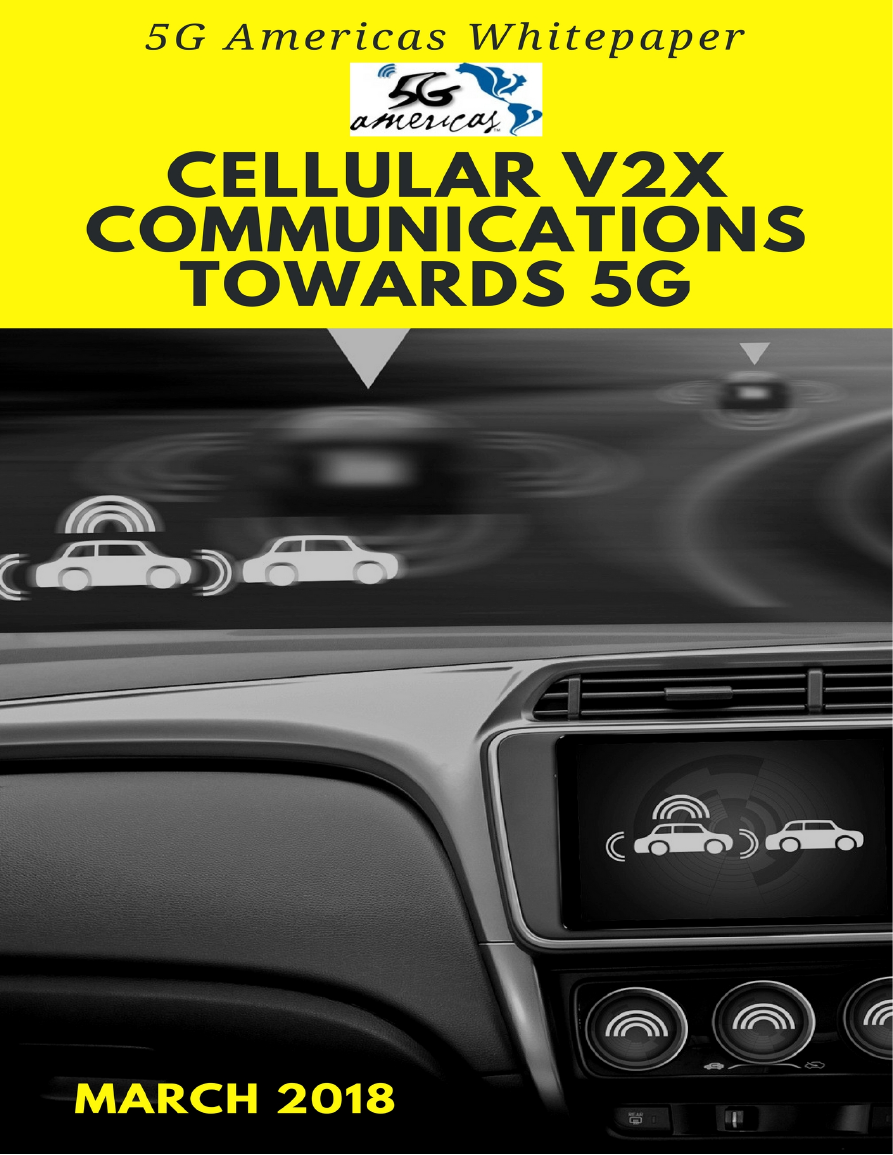
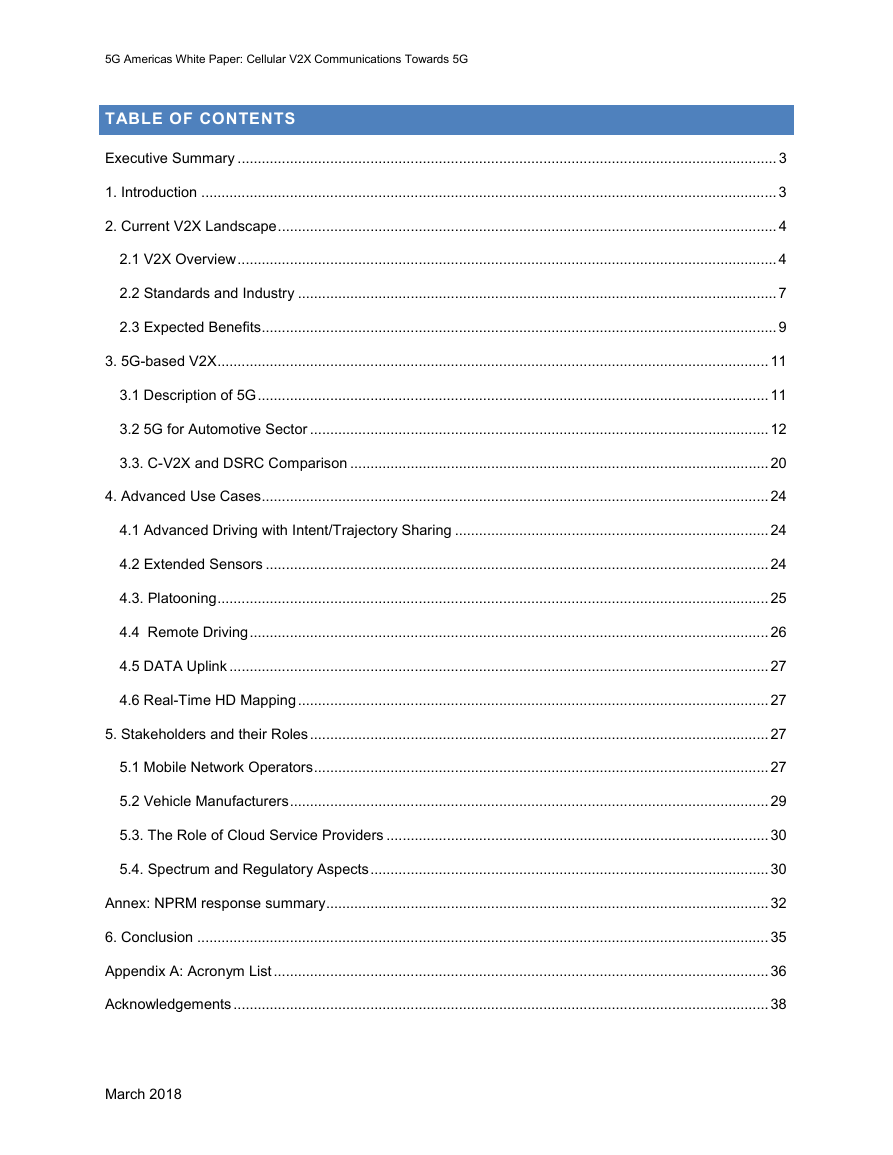
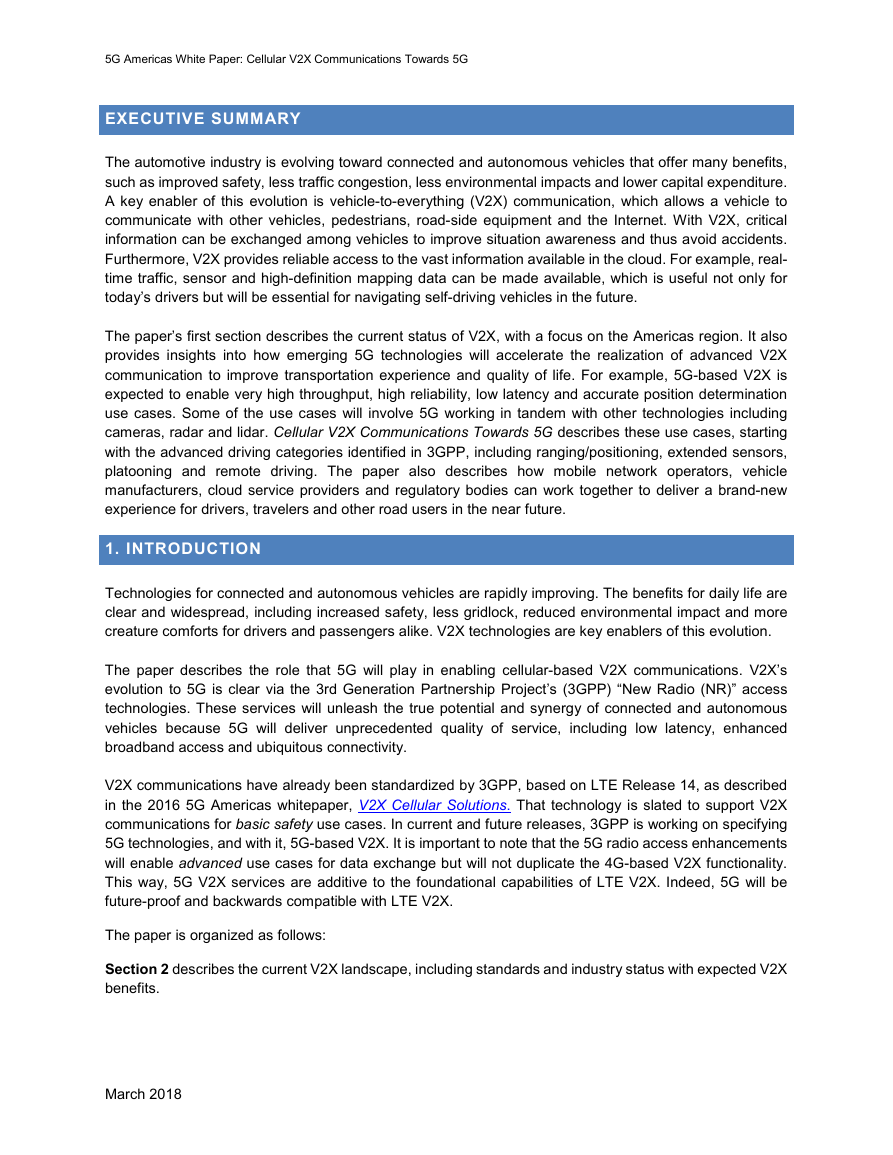
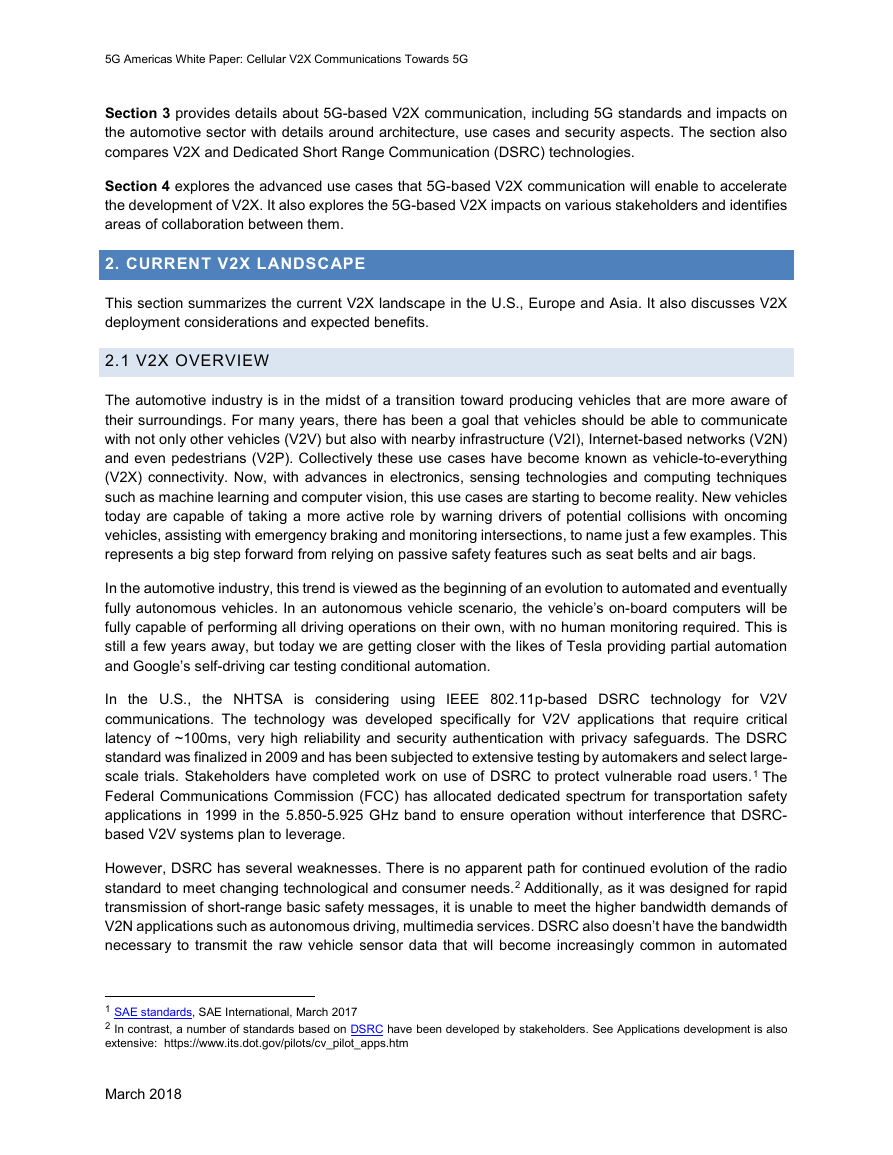
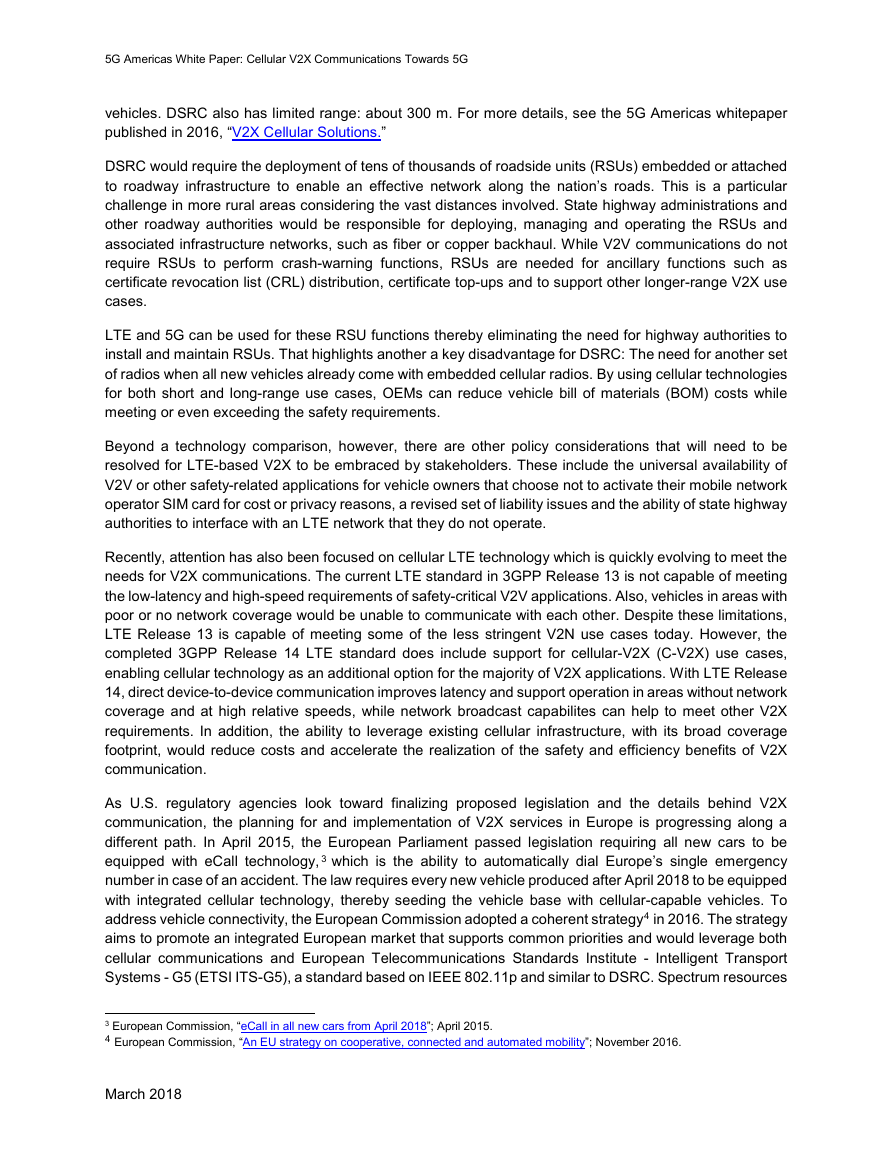
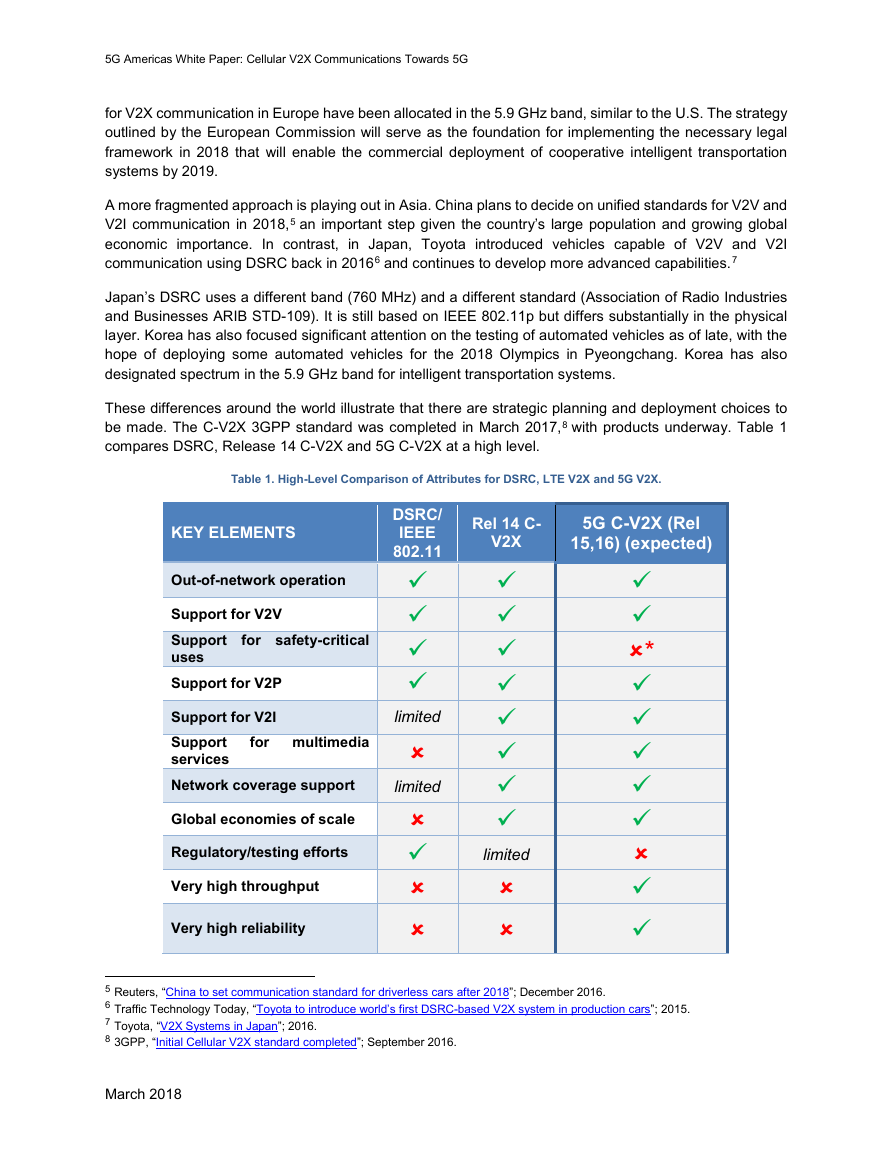
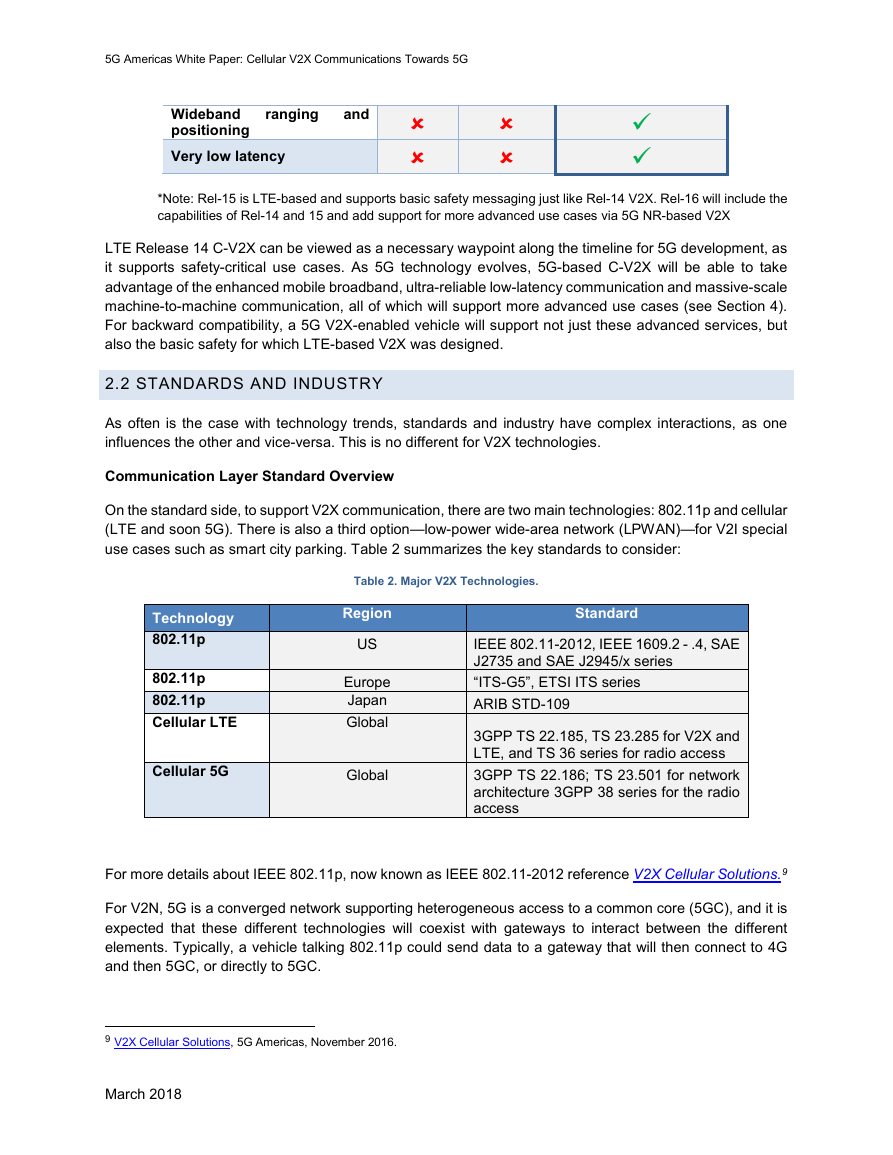









 2023年江西萍乡中考道德与法治真题及答案.doc
2023年江西萍乡中考道德与法治真题及答案.doc 2012年重庆南川中考生物真题及答案.doc
2012年重庆南川中考生物真题及答案.doc 2013年江西师范大学地理学综合及文艺理论基础考研真题.doc
2013年江西师范大学地理学综合及文艺理论基础考研真题.doc 2020年四川甘孜小升初语文真题及答案I卷.doc
2020年四川甘孜小升初语文真题及答案I卷.doc 2020年注册岩土工程师专业基础考试真题及答案.doc
2020年注册岩土工程师专业基础考试真题及答案.doc 2023-2024学年福建省厦门市九年级上学期数学月考试题及答案.doc
2023-2024学年福建省厦门市九年级上学期数学月考试题及答案.doc 2021-2022学年辽宁省沈阳市大东区九年级上学期语文期末试题及答案.doc
2021-2022学年辽宁省沈阳市大东区九年级上学期语文期末试题及答案.doc 2022-2023学年北京东城区初三第一学期物理期末试卷及答案.doc
2022-2023学年北京东城区初三第一学期物理期末试卷及答案.doc 2018上半年江西教师资格初中地理学科知识与教学能力真题及答案.doc
2018上半年江西教师资格初中地理学科知识与教学能力真题及答案.doc 2012年河北国家公务员申论考试真题及答案-省级.doc
2012年河北国家公务员申论考试真题及答案-省级.doc 2020-2021学年江苏省扬州市江都区邵樊片九年级上学期数学第一次质量检测试题及答案.doc
2020-2021学年江苏省扬州市江都区邵樊片九年级上学期数学第一次质量检测试题及答案.doc 2022下半年黑龙江教师资格证中学综合素质真题及答案.doc
2022下半年黑龙江教师资格证中学综合素质真题及答案.doc